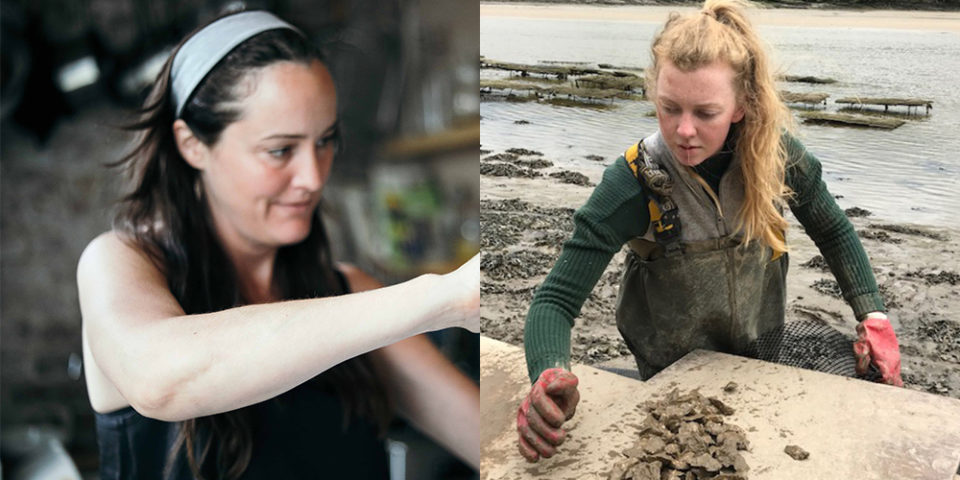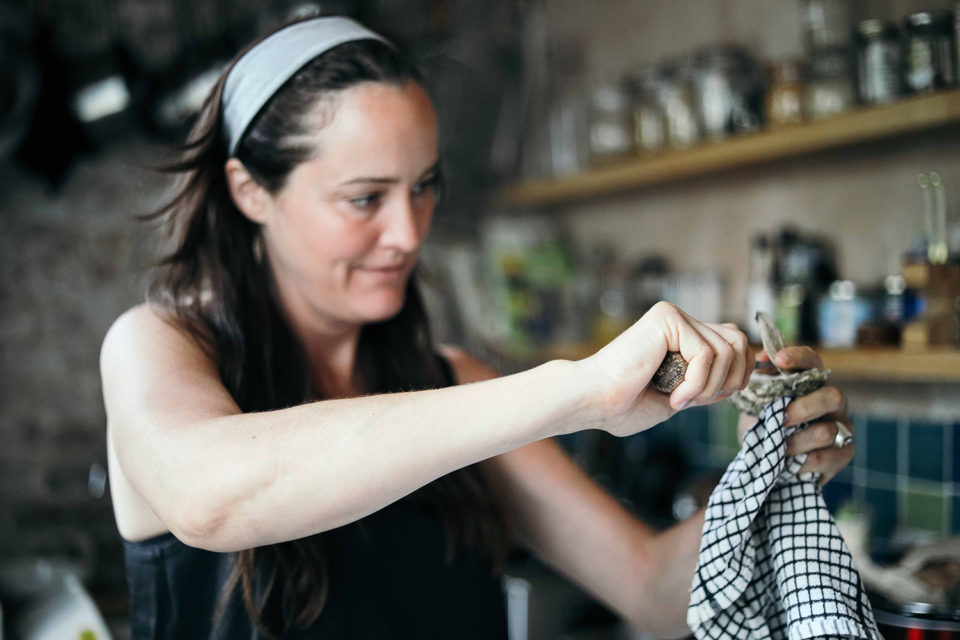For two women at opposite ends of the shellfish supply chain, the mission is the same – more oysters!

The earnest farmhand
For Fiona Edwards, standing outside in the cold and wet for days on end is just part of her job. She’s an oyster farmer on the River Avon in Devon, southwest England.
“It wasn’t my first choice of profession,” the 23-year-old admitted. “I was studying languages at university but became disillusioned with the career prospects and the thought of spending my life working indoors.”
Edwards’ father, Tim, was managing an oyster nursery for Porlock Bay Oysters, a Community Interest Company (CIC), and offered Fiona a job until her future became clearer to her. Two years on, Edwards is supervising the farm part time while studying a science-access course at Plymouth College. She is also looking forward to taking up a place at Plymouth University in the fall to study for a bachelor’s degree in marine biology and oceanography.

In the meantime, she has become a proficient oyster farmer, producing Pacific oysters (Crassostrea gigas), and learning all aspects of the trade while working the nursery site on the Avon. She oversees the transfer and on-growing of part-grown oysters to Porlock on the north Devon coast. Along the way, she has also become an adept boat handler, negotiating the small tender up the river from Bantham, to reach the oyster lease. This is granted by the Bantham Estate on a rolling three-year agreement.
“We buy seed oysters weighing 0.2 grams from Guernsey Sea Farms, place them in fine mesh bags and tie them to metal trestles placed on the sea bed,” said Edwards.
The oyster lease runs up the sides of the river and allows for 600 trestles, 500 of which are currently occupied. At full capacity the site can hold 600,000 oysters of all year classes.
“The route to success is to regularly grade the oysters, and each bag is sorted three to four times per year,” she explained. “The aim is to reduce the numbers of oysters per bag as they grow, and to progressively increase the mesh size of the bags. In this way the oysters have plenty of room to grow, and do not over-compete for food.”
Grading the traditional way includes emptying the bags onto a metal mesh grid and moving the oysters over it by hand. This allows the smaller ones to fall through and be separated out. Similar-sized oysters are placed back into bags, which are reattached to a trestle.
It wasn’t my first choice of profession. I was studying languages at university but became disillusioned with the career prospects and the thought of spending my life working indoors.
It can be backbreaking work, Edwards said, but there is also a rhythm to the task and she enjoys all the fresh air she gets in the beautiful estuary.
“It’s not all rainy days; there are plenty of sunny days to be thankful for and we are surrounded by birds and other wildlife,” she said. “And studying all the other marine creatures we find around us has been the inspiration for my marine biology course.”
Access to the oysters can only take place during high-water spring tides, when the water falls low enough for the trestles to be uncovered by the water. This means that work is concentrated into two weeks of every month.
“Volunteers from the community fishery regularly come down to help us with the grading and sorting, and our aim is to provide them with around 12,000 oysters per month for the transfer to Porlock,” she said.
Porlock lies on the Bristol Channel, which has the second-highest tidal range in the world, carries a heavy load of silt, and is fully exposed to the sea from the northwest.
“Porlock provides some very challenging conditions for the oysters and the first trials growing them from small seed size on this site did not fare well. The only way the project could become viable was to nurture the oysters to a larger size in our more sheltered river environment. However, a second lease site has now been obtained, and is situated where native oyster storage ponds once stood, so we hope that it may provide a kinder environment,” said Edwards.
Once moved, the oysters spend two to three months taking on the local terroir, which benefits from the fully saline conditions. They are mainly sold to the UK restaurant trade, where the local community story and the quality of the product is appealing to a growing market.
The master marketer
Working at the other end of the supply chain, although she can frequently be found helping out on an oyster farm, is Katy Davidson. Most often referred to as “The Oyster Lady,” Davidson has spent many years campaigning to raise the profile of oysters in the UK.
Over the past decade she has shucked oysters at foodie events, given master classes and chef demos, set up and run oyster bars, and catered for weddings, parties, premieres and other events.
She has also set up an Oyster Academy, which helps to educate the public, chefs and restaurateurs, and has been developing an ostrelier qualification.
“People can train as a sommelier, so why not as an ostrelier?” Davidson asked. Such a position, she added, would help dissolve diners’ misconceptions about oysters.
“If there was more education about this fantastic bivalve, we would see a lot more of them being eaten,” she said. “I try to break down barriers such as sourcing, storage, handling, display and preparation, and provide tasting notes and information on sustainability, which more and more customers are interested in.”

Davidson’s Oyster Lady CIC has social/environmental aims at its core and surplus funds are invested through the Oyster Academy into oyster restoration projects, education, research and community-supported aquaculture schemes such as the Billion Oyster Project in the USA.
Her latest project is the highly successful London Oyster Week, which premiered at the end of April 2018. A celebration of oysters at venues across London, it involved curated gatherings at top restaurants, pop-up events, oyster-and-drink pairings with sponsors and ostrelier masterclasses.
Diners were encouraged to purchase “oyster passports” that gave them preferential rates at all featured events.
“London Oyster Week was a huge success, with hundreds of people joining us at 25 venues across the city to appreciate and celebrate our thriving oyster culture, whilst learning about the importance of oysters in their natural habitat,” said Davidson.
“We also had a calendar of sold-out events with sponsors Bruichladdich Whisky, Mount Gay Rum and Remy Martin, which allowed us to introduce diners to the delights of oyster mixology and spirit matching.”
I try to break down barriers … and provide tasting notes and information on sustainability, which more and more customers are interested in.
A particular highlight was a gathering at Northbank Restaurant, where several oyster farmers presented their own oysters to guests and explained the farming process.
Amanda Anderson from Isle of Barra Oysters found the event to be a “fantastic night,” with positive feedback from all the guests.
“We would be more than happy to support a future London Oyster Week and to help the Oyster Lady in her quest to change the world one oyster at a time,” she said.
As an inaugural event, Davidson was delighted at the level of interest shown by the media, and especially the opportunity to appear on a popular TV program sharing oysters with popular musicians Sting and Shaggy.
“All the media coverage was positive, which helps to spread the message about oyster eating. And with such a successful first year, we will definitely be building on the event for 2019 to make it bigger and better for all involved,” said Davidson.
To keep her busy in the meantime, Davidson is researching and writing an oyster cookery book, which she hopes will get even more people interested in eating her favourite seafood.
Follow the Advocate on Twitter @GAA_Advocate
Author
-
Nicki Holmyard
Nicki Holmyard has written about the seafood industry for longer than she cares to remember! A committed pescetarian, she is also a partner in the UK’s first fully offshore rope-grown mussel farm.
Tagged With
Related Posts

Intelligence
As sturgeon farming grows, demand concerns emerge
Caviar, or lightly salted sturgeon roe, has been enjoyed for centuries as an expensive gourmet delicacy. After a drastic decline in wild sturgeon stocks, aquaculture stepped in to fill the void. But can farmed supply find lasting balance with market demand?

Responsibility
Can aquaculture flourish in a more symbiotic sea?
The 18-month Maribe project has uncovered some promising ideas for promoting growth and jobs within the blue economy. Aquaculture, fingered as one of five key areas for growth, could benefit from collaboration with renewable energies.

Health & Welfare
Fish producers benefit from humane slaughter techniques
EU legislation requires farmed fish be spared unnecessary pain, distress or suffering at slaughter, and efficient manual and automated systems have been developed to help achieve this goal. What’s more, longer shelf life and improved flesh quality have been reported.

Health & Welfare
On the Job: Young fish veterinarian holds a hopeful outlook
Harry Hamlin-Wright is a fish vet. It’s a career choice that gets strange looks but offers him varied and interesting work. See the world of aquatic animal health and welfare through a fresh set of eyes in a new Advocate series on aquaculture jobs.


